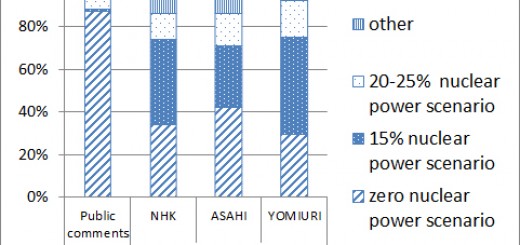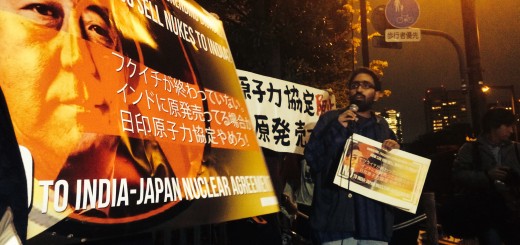Report on two lectures by Prof. Frank von Hippel 
Prof. Frank von Hippel, from Princeton University’s Program on Science and Global Security, gave talks in Tokyo on ‘Monju and Japan’s reprocessing policy’ and ‘Reducing the danger of spent fuel pool fires’ on November 21 and 22 respectively. The lecture on Monju was a pre-event for PuPo2017, the international conference that CNIC will be holding jointly with the Union of Concerned Scientists in Tokyo next February (see page 5 for details). The lecture on spent fuel pools was well attended by the media, especially because that very morning the coolant pumps at the Fukushima Dai-ni NPS Unit 3 spent fuel pool (SFP) had failed in a strong earthquake. Even though cooling systems were restored within two hours, this was a reminder for many in Japan of the narrowly avoided disaster of the Unit 4 SFP at Fukushima Dai-ichi NPS over five years ago.
Prof. von Hippel explained exactly how close to catastrophe we came in March 2011, and that the reason the Fukushima Dai-ichi Unit 4 SFP didn’t catch fire was due to a fortunate coincidence that water was leaking into the pool from the adjacent reactor well. The water that TEPCO was adding via a ‘giraffe cement pump’ was inadequate to keep the spent fuel covered and within a month the rods would have been almost totally exposed, most certainly leading to a fire and a vast release of Cesium 137. The Unit 4 SFP contained 900 PBq (= Peta Bequerels, 1000 trillion disintegrations per second) compared to 700 PBq in the melted fuel of the reactors No. 1-3 and if there was a fire, up to 90% of this would have been released into the atmosphere (compared to only 1-3% of the cesium in the melted reactors). This would have required evacuation of 1.6 million people if the wind was blowing offshore and 35 million, including Tokyo, if the wind was blowing onto land. When we think of the ongoing disaster of Fukushima Dai-ichi, and realize that it could have been a hundred times worse even than what did happen, that we were ‘saved’ by a fluke water leak and that the fate of millions of people could depend on the wind direction, the extreme danger of SFPs becomes very apparent.
Prof. von Hippel’s proposal is that fuel rods in SFPs be removed after five years and put in dry cask storage which are passively cooled by natural air circulation. While this is not without risk (the casks could be attacked by terrorists), the risks are considerably reduced compared to the present situation, especially considering the high-density racking which has been routinely adopted in SPFs in both the US and Japan. Low density open racking would allow some degree of air cooling if there is a loss of coolant in an emergency but high density racking packs the spent fuel rods so close together and surrounds them with neutron-absorbing partitions to prevent chain reactions, so air-cooling is not possible. Also the greater the number of fuel assemblies, the more hydrogen that would be produced by steam reactions with the hot fuel and the more likely a hydrogen explosion that would destroy the reactor building creating a situation in which cesium-137 from the burning fuel would be released directly into the atmosphere rather than plating out on the building walls.
Compared to the risks with this type of storage, dry cask is obviously much safer, but Prof. von Hippel explained to us that in the US, the Nuclear Regulatory Commission (NRC) in its cost-benefit analysis, systematically underestimated the economic impact and risk of a fire in a high density SFP by such means as assuming that decontamination in case of an accident would take less than a year, that the population relocation dose level would be three times higher than in Fukushima or Chernobyl and completely excluding terrorism risks. The nuclear industry obviously does not want to pay for the added cost of either low density racking or extra dry casts, preferring to ignore the real risks, a story we are all too familiar with in Japan especially after Fukushima.
The dangers and high costs of reprocessing
On the other hand, in his lecture on Monju, Prof. von Hippel explained how the government in Japan continues to pursue its reprocessing program despite the enormous costs involved, the repeated technological failure of sodium-cooled reactors, as evidenced by the failure of 20 years of efforts to operate Monju and recent moves to close it, and the significant dangers of proliferation and terrorism from separated plutonium.
In the 1970s it was predicted around the world that plutonium breeder reactors would become the dominant source of electrical power globally and in the US would, by 2000s, have reached a capacity where they could have generated four times total US actual electrical power consumption. Of course at that time, the projected total electricity capacity was also greatly over-estimated, but the capacity of breeder reactors within the total, turned out to be spectacularly wrong. Monju is a very clear example of the technical problems that liquid sodium cooled reactors face: sodium, being flammable if it comes in contact with air or water, is not an easy coolant to work with, as the sodium fire accident in 1995 and then a refueling machine accident in 2010 show. While the Japanese government has finally admitted that Monju is unworkable, they have not let go of the fast breeder dream and have come up with other arguments to justify the reprocessing program. These include the claim that the spent fuel waste is made less dangerous by separating out and fissioning the plutonium, and also that the amount of waste is reduced, but, as with the NRC analysis mentioned above, the authorities manipulate the data to justify their argument. Prof. von Hippel gave us detailed evidence (please see his slides on our website
www.cnic.jp/english/?p=3592) that it is much more dangerous to separate out plutonium, creating more waste streams, than it is to simply dispose of it as high level radioactive waste in an underground repository. Not to mention the serious danger of the huge stockpile of plutonium which Japan has amassed, in terms of proliferation and terrorism threats.
Prof. von Hippel’s talks gave us plenty of hard evidence with which to counter the various arguments put up by the nuclear industry and governments. We must make sure this information is used effectively to force changes in nuclear waste disposal policies.
(Caitlin Stronell, CNIC)





